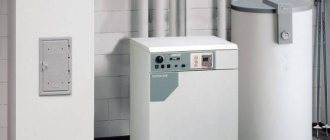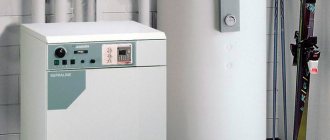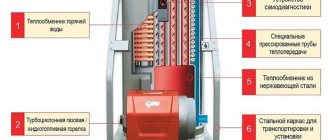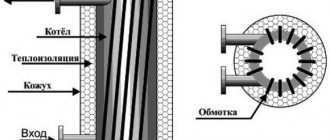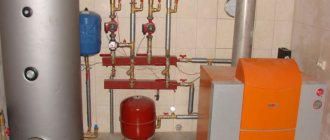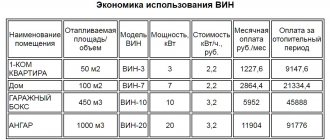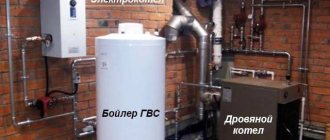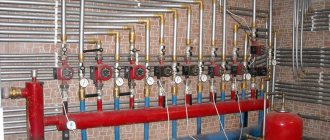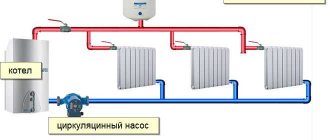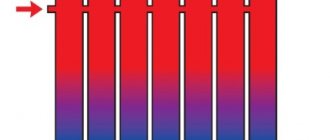Operating principle of air heating
Air heating is a widespread heating system in Western countries for buildings, as well as production and storage facilities. This is a universal system that allows you to combine heating, ventilation and air conditioning. Air heating provides high efficiency (up to 93%), is economical and easy to maintain.
An air heating device for heating cottages provides a comfortable microclimate, as it prevents overheating or hypothermia of indoor air, and also allows you to control air humidity.
The air heating system includes:
1. Heat generator (heater), which heats the air. 2. A network of air ducts supplying heated air to the premises. 3. Distribution grilles that direct air movement in the desired direction.
As a rule, the heat generator is equipped with a burner, combustion chamber and heat exchanger. When fuel burns, the heat exchanger heats up and transfers heat to the air passing through it. The heated flows enter the air vents and are directed into the room. Combustion products escape through the chimney. The picture below shows a diagram of air heating.
Air heating circuit
Fuel can be used as a heat source: gas, electricity, solid and diesel fuel, as well as heated water from the central boiler house. In a private home, in a warehouse or in a greenhouse, it is convenient to use solid fuel (firewood, coal, wood waste). For air heating of private houses, round or rectangular air ducts are usually used. Round air ducts 10-20 cm in diameter are characterized by low aerodynamic resistance. Rectangular air ducts are made in the form of boxes, most often with a cross-section of 10x15 or 32x40 cm. They are compact and easy to install.
Modularity of heating equipment
Lack of gas air heating . Any gas air heating furnace is a device that has both a fan and gas burners in one housing. This leads to the fact that the dimensions of such a stove are comparable to the dimensions of a small refrigerator, and it usually weighs more than 80 kg. It is quite difficult to transport and carry such a unit, and certain difficulties may also arise during its installation.
The advantage of the Anteres Comfort air heating system . Our air heating system Antares Comfort follows the principle of modularity - it consists of separate, fairly small blocks. For example, an AVN air heating unit generally consists of 2 main blocks - the BV fan unit and the body of the KBN heater unit. In this case, during installation, the KBN is simply placed on top of the BV fan unit. They are transported separately, each in their own packaging, and each block weighs no more than 30 kg. Those. Even one person can carry it, and elements of our heating system equipment can be transported in a passenger car. Drag and drop during installation and maintenance of a modular system is also much easier.
Types of air heating
Air heating systems are classified into several types.
Based on the principle of air circulation : forced and natural air heating systems
— The forced system includes a fan that creates the necessary pressure to move air flows. Most often, the fan is located at the bottom of the heater.
— The natural (or gravitational) scheme operates by changing the density of heated air. Such a system does not depend on the supply of electricity, but the circulation of air masses in the room may be unstable and may be disrupted by an open window or draft.
For air recycling : direct-flow and recirculating air heating systems
– Direct-flow heating . The heated air is directed into the premises, where it gives off heat, picks up carbon dioxide, allergens and microbes, and then is carried out by reverse draft through the shaft. Instead, fresh air comes from the street, which heats up and goes through the cycle again. The direct-flow scheme is the most hygienic, but at the same time thermal energy is carried out with the exhaust air. To reduce heat loss, recuperators are used, where exhaust warm air transfers part of the heat to the incoming flow coming from the street.
– Recirculation heating differs in that the air used the first time is not removed from the system, but is again sent to the heat exchanger, where it is heated for reuse. To saturate with oxygen, a mixture of fresh air from the street is used. Thermal losses of the system are reduced, but hygiene is reduced, since more dust settles in the air ducts and harmful substances can enter the premises again. Recirculation is used where hygienic requirements for ventilation are not so important.
For distribution of warm flows throughout the premises: duct and local air heating systems
— Duct air heating . There is an air duct system through which air is supplied and distributed throughout the rooms of the house. All parameters (temperature, humidity, air exchange rate) can be adjusted using automation and a system of sensors installed in the premises. Automation saves energy costs by reducing heating when necessary (for example, at night or in the absence of residents). The air heater processor can also control the air conditioner, humidifier, electronic filter and other additional equipment. These functions can be modularly added to the basic heating system at any time at the user’s request. Combustion products are discharged outside through the chimney.
— Local air heating . In this case, heating equipment is installed directly in the heated zone - most often such a system is used for heating production and storage facilities, as well as greenhouses, garages, basements and utility rooms. The air in the room is heated directly by air heaters. For industrial and agricultural facilities, this is the most economical method of air heating, both in design and installation, and in using the system.
Purpose of the ventilation system
Whatever the purpose of the room, ventilation ducts are its integral attribute. This especially applies to residential buildings and apartments, since during human activity dust, excess moisture and unpleasant odors, as well as carbon dioxide, accumulate. All this is removed outside through ventilation, and in return fresh, oxygen-rich air enters the room. In addition, thanks to the hood, condensation does not accumulate on the walls and fungus does not grow.
Thus, ventilation systems are designed to circulate oxygen in the room. There are exhaust and supply and exhaust ventilation systems. When using a supply and exhaust ventilation system, a recuperator is installed. This means that the warm air leaving the room will transfer some of the heat to the incoming flow. As a result, heat loss will be noticeably lower.
Design and calculation of an air heating system
To install air heating, you need to draw up a preliminary project. To do this, you need to calculate the following indicators:
— heat loss of the room; — required power of the heat generator; — heated air supply speed; — diameter and aerodynamic characteristics of air vents.
A professional calculation by our specialists will help you avoid drafts in the room, noise and vibration in the house, as well as overheating of the heat generator. It is better to think about the installation location of the equipment in advance.
When using air heating from a single heat generator, it is necessary to resolve the issue of air duct routing. To achieve the most effective heat distribution in a room, it is necessary to place the warm air supply as close to the floor as possible, since in this case, effective heat distribution by convection is achieved at a low air flow rate. The heated air itself tends to rise from the floor to the ceiling, uniformly warming the entire volume of the room. But, since the air enters from below, the air ducts have to be covered with decorative coverings or laid under the floors between the joists.
Is it possible to install air ducts under the ceiling? Can. Technically it is much easier. But then you will be faced with the following problem: in order to “push” heated air into the room all the way to the floor, you will have to significantly increase the pressure in the system and increase the air flow speed. At the same time, energy costs increase sharply, as well as acoustic effects in air ducts (noise, whistling, knocking, vibration). Additional discomfort will be created by the noise of the air flow at the outlet of the distribution grilles (remember the thermal curtains at the entrance to shopping centers and imagine that they are noisy in your room).
The installation option is somewhat easier when air conditioners or heat pumps are used for air heating. In this case, warm air is produced by the device directly in the room, so there is no need for air ducts. Freon lines are used here for heat exchange. They are much thinner than ductwork and are easy to install under the ceiling.
How to calculate an air heating system
To make a thermotechnical calculation of air heating - combined with ventilation or carried out separately - heating engineers take into account many parameters:
• Heat loss in the room (depends on the material and thickness of the walls, the number and area of windows, etc.); • The number of people who will be in the room; • Number and power of additional heat sources; • Heat inflows from operating equipment or devices, etc.
The simplest scheme looks like this: 40 watts of thermal power per cubic meter of heated room. For the regions of the Far North, when taking into account extreme temperatures in winter, a coefficient of 1.5-2.0 is accepted. Another approximate scheme for buildings with a ceiling height of no higher than 2.5 - 2.7 m. Here, a heat generator with a power of approximately 1 kW is used to heat 10 m2 of building area. For areas with severe frosts, increasing coefficients are taken into account.
System installation features
If the calculations are carried out at a high professional level, and the design of the cottage air heating system is drawn up, you can carry out the installation yourself.
For this you will need:
- heating device;
- air ducts;
- fan;
- gratings;
- fasteners;
- tool for working with air ducts, etc.
A gas generator is usually used as a heater as the most cost-effective option. Air ducts can have a rectangular, square, round or oval cross-section.
Typically, suitable designs can be ordered from a company that manufactures ventilation systems.
The diagram shows the elements of the air heating system, which will allow installation of air ducts in strict accordance with the design documentation
Typically, air ducts are made of galvanized steel; they are light enough so as not to overload the supporting structures of the house, and also have increased resistance to wear and corrosion. For rigid air ducts, you will need special elements that provide a slope of 45 or 90 degrees. But for flexible products such elements are not needed.
Air ducts are also made from ordinary steel, copper, plastic and other materials. There are even textile designs of this type. In places with high humidity, it is recommended to use copper elements as they are more resistant to such conditions.
Plastic structures are relatively inexpensive and can be used away from potential sources of fire.
Air ducts are fixed under the ceiling and floor, as well as inside the walls. If there is a need to lay the air duct not inside, but along the wall, it is covered with a false panel. Ventilation grilles are installed in the ceiling and floor at the ends of the air ducts.
Rigid air ducts made of galvanized steel are very reliable and durable. For their successful installation, you will need elbows with a rotation angle of 45 and 90 degrees.
Air masses moving inside a structure can make some noise. To reduce this negative impact, it is recommended to hide the air ducts under a layer of sound insulation.
Typically, this material also has thermal insulation properties, which only increases the efficiency of the system.
To ensure that air heating structures make as little noise as possible during operation, it is recommended to cover them with a layer of insulating material
It is worth considering the option of purchasing air ducts that already have such an insulating layer applied. This will simplify and speed up installation work.
If there is a need to install a fan, or several such devices, then it is usually included in the system next to the heater. The fan is supplied with power and also provides a backup source of electricity.
The system also includes one or more filters. These can be mechanical cleaning filters that prevent the spread of dust particles. Along with these devices, it is recommended to install a carbon filter that absorbs various odors. Of course, filters need to be cleaned and/or replaced periodically.
Part of the air duct is led outside to provide fresh air. This section is supplied to the filter system, and then the air is supplied to the heat exchanger of the heating device. If installation work is carried out during the construction of a house, then its implementation usually does not cause any great difficulties. The main thing is a good project.
To improve the microclimate in the house, useful elements such as an air humidifier, ionizer, ultraviolet sterilizer, etc. are built into the air heating system. These elements are not mandatory, but if funds allow, you should not refuse them.
Another useful device is a ducted air conditioner. It is also built into the air duct system. This will allow you to use the system in the warm season to cool the air in the room.
Automatic control systems significantly improve the operation of the air heating system and reduce heat costs, as well as simplify the operation of equipment
The final stage is connecting the automatic control system. You will need air temperature sensors in the rooms and a control panel with a processor that will process the received data and regulate the operation of the heating equipment.
Selecting a heat generator for air heating. Heat sources
The cost of installing the system largely depends on the choice of heat generator. They can be mobile or stationary.
Mobile heat generators are most often used at industrial and agricultural facilities as a backup heat source in case of accidents and outages of the main energy source. In domestic use, these can be well-known heat guns and heaters (gas, diesel, electric), which are useful in repairing and building a house, heating a garage, drying a basement, etc.
Stationary heat generators are used for constant air heating of the building. They are installed in pre-prepared places with a smoke exhaust system (if combustion energy is used rather than electricity). They, in turn, can be suspended (for local heating of one room) and floor-mounted (for heating the entire house).
Among the suspended heat generators are air heaters, air heaters, gas convectors, and various types of heat curtains. The heater is often used in small country cottages and dachas with intermittent occupants, as it can warm up a room in a matter of hours, does not take up much space, is safe to use and operates very quietly.
Floor- mounted heat generators are more capital; they are capable of constantly heating a large house of several floors thanks to connected air ducts. A flow of warm air is supplied to all rooms and creates a comfortable microclimate for permanent residence of residents during the cold season.
The air heating system can be implemented using various types of fuel and coolants.
Solid fuel boilers and stoves
The traditional Russian stove (and other classic stoves and fireplaces) cannot yet be classified as an air heating system in the strict sense of the word. But as soon as we add special channels or heat exchanger pipes that circulate and supply heated air into the room, we get the simplest air heating system. If we also create a network of air ducts that distribute warm air throughout the rooms and floors, then we will get a full-fledged heating system. Its effectiveness can be enhanced by forced circulation by a fan.
The most popular stove for air heating is Buleryan. The manufacturer's name has long become a household name for all pyrolysis furnaces with heat exchange pipes that circulate heated air. Heated air from the furnace can be distributed throughout the rooms and floors using aluminum air ducts with natural or forced circulation. Another popular option is an air-heated fireplace. It differs from a simple fireplace in that it is housed in a shell made of cast iron or steel, from where hot air enters the premises through a network of air ducts.
Gas boilers and climate control systems based on them
A gas boiler can be used as a separate air heating device, and as part of a climate complex. In the first case, gas, when burned in a boiler, heats a heat exchanger through which air is forced. The heated air mass is distributed throughout the rooms. In the second option, additional equipment is used along with the boiler:
• Recovery system (allows you to reuse the heat of the exhaust air, thereby reducing heat loss); • Air conditioning system (usually a duct air conditioner is installed in the air ducts); • Air humidifier (maintains air humidity at a level comfortable for health); • Ultraviolet disinfectant (cleanses the air of pathogenic microbes and bacteria); • Dust filter (cleanses the air of dust, lint and allergens) • Automatic control
The cost of such a turnkey climate control system can range from 1,300 to 3,000 rubles per 1 m2 of building area. In addition to air heating, it includes air conditioning and ventilation with air purification, that is, complete climate control of the entire house.
Electric air heating systems
The simplest electric air heating system is a conventional fan heater. Consuming a power of about 2 kilowatts, it quickly heats up the air, driving it through a hot spiral. The disadvantages of its use include low energy efficiency and deterioration of the air in the room due to the combustion of oxygen.
Heat guns and electric convectors with a low-temperature heat exchanger can create quite comfortable conditions in the premises. By adding a heat recovery system to them, you can significantly save energy costs. Electric air heating systems are widely used in industrial and public premises, as well as where it is necessary to quickly heat the air during work (garage, basement, workshop, warehouse, etc.)
Air source heat pump
A heat pump is capable of taking heat from the earth, water, and outside air, and using it to heat the home. There are different types of heat pumps: - Ground-to-air heat pump - Water-to-air heat pump - Air-to-air heat pump
For the first type, heat exchanger probes are used in the non-freezing layer of the earth, for the second - a similar heat exchanger in a well or reservoir. Air-to-air heat pumps are better known as air conditioners set to “heat.” The unit takes air from outside, heats it in the internal circuit and sends the heat through the freon line into the house. A common problem with such installations is the dependence of their efficiency level on the weather. During severe frosts, air-to-air devices cannot produce the required amount of heat.
A little about the system
To briefly describe the operating principle of gas-air heating, we can say that it is a system that heats a room by supplying a powerful jet of hot air.
It should be noted that recently gas-air heating systems have become increasingly in demand.
There are several reasons for this:
- Availability of fuel. Gas is by far the most inexpensive type of fuel used in heating systems.
- Low cost of equipment. Because such a system only requires an air heater and an air duct system. That is, no money is spent on pipes and radiators.
- Easy to install.
- High level of safety - the possibility of a pipe or radiator bursting due to their absence is eliminated. In addition, the heat generator itself is equipped with a significant number of sensors that help monitor its operation.
- High heating speed. This system allows you to warm up the room to a comfortable temperature in a short time.
- Wide range of applications. Gas-air units are perfect for heating private homes and maintaining heat in industrial and industrial premises.
- Economical. If you set the heat level to a low level, you can significantly save fuel.
Installation of an air heating system for a private house
Our company installs a turnkey air heating system, including calculations, supplying equipment of the required power, assembly and commissioning. Air heating of private country houses includes:
– air ducts; – heat generators; - fan; – decorative grilles; – sleeves for collecting air from the street.
The equipment we offer runs on both gas and electricity. Water heating pipes and tanks can also be used as a heater when the house has a centralized water heating system. The optimal air heating system for cottages, according to our experts, should operate on the basis of natural gas. If it is not possible to connect to the gas mains, we recommend that customers have an autonomous gas heating system. We will install and connect the liquefied gas tank (gas holder).
The assembly of the air heating system takes place in stages
1. Installation of the boiler and heat exchanger. Air heating of a private cottage begins with the installation of a boiler. The boiler is usually installed in the basement. Please note that it is strictly prohibited to connect the boiler to the gas main yourself; you must call a gas service specialist.
2. Installation of heat exchanger and fan. A connection is made between the upper part of the heat exchanger and the supply air duct. A fan is installed under the combustion chamber, to which a return pipe is connected.
3. Layout and installation of air ducts. The wiring operation involves connecting flexible air ducts, usually with a circular cross-section, to the supply channel main. Then the return air duct is assembled. Its diameter is larger, but such a channel has fewer outlets than the supply channel.
4. Insulation of all air channels. In order to prevent condensation from appearing in the sleeve, the sleeve must be insulated.
5. Construction of a hole in the wall of the building through which air intake from the street will pass, followed by installation of a hose. A throttle valve is installed in the pipe, which regulates the amount of fresh air entering the building.
6. Installation of decorative grilles and boxes. When the entire system is assembled, decorative grilles and plasterboard boxes are installed to cover the mounted equipment.
At the same time, take into account the need to leave access points for equipment maintenance and cleaning of air ducts.
Warm up your home quickly
Lack of gas air heating . As mentioned above, the usual snail fan, which is found in most air heating furnaces, is unregulated; it always rotates at the same speed. The amount of gas burned in the stove is adjusted, but usually only once, during the initial setup. Therefore, in such air heating systems there are only 2 operating modes - either the heating works or it doesn’t. Your home with a gas forced-air heating system will always heat at the same rate. It will not be possible to quickly warm up the house if necessary.
The advantage of the Anteres Comfort air heating system . The German fan installed in the air heating unit has speed control. Therefore, usually when setting up an air heating system, the operating mode of the fan speed is set to, say, 40...50% of the maximum, and if necessary, it can be quickly changed to an accelerated heating mode at 100% speed. The noise level will of course be higher, but the amount of air supplied to the rooms, and therefore the heat transferred by it, will also increase significantly and the house will warm up much faster. This is very important if you come to an unheated house on the weekend and don’t want to wait until the evening for it to warm up normally. An hour or two of accelerated heating - and the house is already warm, there is no need to raise the temperature further, you just need to compensate for the cooling, and much less heat is needed to compensate than to raise the temperature. Therefore, less warm air is needed and the fan can operate at lower speeds almost silently.
Contract for an air heating system and a complete set of documents
Our company works with legal entities and individuals. We conclude an agreement for all services provided, which is a document that clearly defines the cost and timing of the work. Pre-agreed terms reduce risks for both parties, and also ensure the benefits of the transaction for the seller and buyer. Signing the certificates of completed work and acceptance and transfer of equipment means the successful completion of the work. We provide a full package of documents, including invoices, acts, invoices and cash receipts for cash payments, commissioning reports, and system settings. After completing the work, we continue to work with you as a consultant and service organization.
An engineer’s visit to calculate the cost of work is free of charge.
Our company provides services for the installation of air heating, ventilation and central air conditioning for private homes, industrial and warehouse enterprises, and commercial buildings. All engineering solutions of the projects comply with the requirements of SNiP.
Do-it-yourself air heating. Accessories.
The supply units were ordered from a special plant that produces air ducts for ventilation and air heating. Standard products—throttle valves, grilles, inserts, and others—were purchased from a company that sells ventilation equipment. Flexible insulated noise-attenuating air ducts were also purchased there. However, they can also be bought on the construction market.
We also bought foil self-adhesive insulation, mounting tape, aluminum tape, and self-tapping screws at the construction market. Although you can buy them at a hardware store or online.
Since the owner wanted to install an air conditioner in the future, all supply air ducts needed to be insulated - otherwise moisture would form on them. It is worth saying that flexible air ducts themselves are insulated, unlike rigid galvanized ones.
Rigid main air ducts can be ordered to be made from galvanized sheet at the factory, and then insulated with your own hands - covered with foil self-adhesive insulation with a thickness of at least 5 mm. But you can try to save money and glue the main air ducts from foamed foil polyethylene with a thickness of at least 10 mm. It is usually sold in rolls.
Air heating: how we work
Order service
Ecolife Engineering Systems company is a team of experienced and licensed specialists in the installation and maintenance of all types of engineering systems with the subsequent preparation of the entire package of documents for sanitary services and other regulatory authorities.
• 5 years in the market of Moscow and the Moscow region • 7 specialized licenses and certificates • 40 employees, 4 company cars and 3 work teams for prompt execution of orders • 2 sets of television inspections and professional European equipment • We will reduce your costs by 20%. Prices for our services are lower than the market average without compromising the quality of work and service.
Why is it profitable to order air heating from IS Ecolife?
• Our employees are certified by equipment manufacturers. Our company is the official service center of global manufacturers of climate control equipment from world brands: Buderus, Hansa, Viessman and others. • When carrying out work, only high-quality and proven materials are used, in the reliability of which we are completely confident. • Our company’s specialists have been working on the engineering systems market since 2005. • Availability of our own production base, all required equipment and devices. Only professional equipment is used. • An integrated approach to the object helps to save the client’s money and ensure that all conditions and requirements are met. • Internal control of all work performed is carried out. Which is usually more strict than that of the customer. After all, we not only provide a guarantee, but also offer further maintenance of the facility. Therefore, competent design, eliminating all errors, choosing high-quality and durable materials is beneficial not only to clients, but also, first of all, to us. • There is no need to waste effort searching for several companies that would separately perform all types of work. There is no need to conclude unnecessary contracts and worry about the quality of all the details by each individual contractor. Our company is capable of fully independently designing, installing, commissioning and servicing.
A professional approach carried out at all stages of activity allows us to reduce additional energy costs to a minimum and eliminates large additional expenses when individual components of the heating system fail.
How to contact us and get more information
You can get detailed advice on all questions related to the installation of engineering systems of objects by calling the installation department of our company. In addition, you can write a letter to the email address, indicating contact information for feedback.
We work with objects
* Manufacturing enterprises, factories, shopping centers * Restaurants, cafes, and all catering establishments * Multi-storey and private residential buildings, office complexes * Clinics, hospitals, schools, educational institutions * Airports, train stations and all government agencies.
Order service
